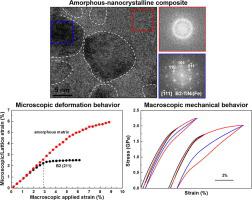当前位置:
X-MOL 学术
›
Mater. Today
›
论文详情
Our official English website, www.x-mol.net, welcomes your
feedback! (Note: you will need to create a separate account there.)
Achieving 5.9% elastic strain in kilograms of metallic glasses: Nanoscopic strain engineering goes macro
Materials Today ( IF 21.1 ) Pub Date : 2020-07-01 , DOI: 10.1016/j.mattod.2020.02.020 Junsong Zhang , Yinong Liu , Hong Yang , Yang Ren , Lishan Cui , Daqiang Jiang , Zhigang Wu , Zhiyuan Ma , Fangmin Guo , Sam Bakhtiari , Fakhrodin Motazedian , Ju Li
Materials Today ( IF 21.1 ) Pub Date : 2020-07-01 , DOI: 10.1016/j.mattod.2020.02.020 Junsong Zhang , Yinong Liu , Hong Yang , Yang Ren , Lishan Cui , Daqiang Jiang , Zhigang Wu , Zhiyuan Ma , Fangmin Guo , Sam Bakhtiari , Fakhrodin Motazedian , Ju Li

|
Abstract The ideal elastic limit is the upper bound of the achievable strength and elastic strain of solids. However, the elastic strains that bulk materials can sustain are usually below 2%, due to the localization of inelastic deformations at the lattice scale. In this study, we achieved >5% elastic strain in bulk quantity of metallic glass, by exploiting the more uniform and smaller-magnitude atomic-scale lattice strains of martensitic transformation as a loading medium in a bulk metallic nanocomposite. The self-limiting nature of martensitic transformation helps to prevent lattice strain transfer that leads to the localization of deformation and damage. This lattice strain egalitarian strategy enables bulk metallic materials in kilogram-quantity to achieve near-ideal elastic limit. This concept is verified in a model in situ bulk amorphous (TiNiFe)-nanocrystalline (TiNi(Fe)) composite, in which the TiNiFe amorphous matrix exhibits a maximum tensile elastic strain of ∼5.9%, which approaches its theoretical elastic limit. As a result, the model bulk composite possesses a large recoverable strain of ∼7%, a maximum tensile strength of above 2 GPa, and a large elastic resilience of ∼79.4 MJ/m3. The recoverable strain and elastic resilience are unmatched by known high strength bulk metallic materials. This design concept opens new opportunities for the development of high-performance bulk materials and elastic strain engineering of the physiochemical properties of glasses.
中文翻译:

在公斤金属玻璃中实现 5.9% 的弹性应变:纳米应变工程宏观
摘要 理想的弹性极限是固体可达到的强度和弹性应变的上限。然而,由于非弹性变形在晶格尺度上的局部化,散装材料可以承受的弹性应变通常低于 2%。在这项研究中,我们通过利用马氏体转变的更均匀和更小的原子级晶格应变作为块状金属纳米复合材料中的负载介质,在块状金属玻璃中实现了 >5% 的弹性应变。马氏体转变的自限性有助于防止晶格应变转移,从而导致局部变形和损坏。这种晶格应变均等策略使千克数量的大块金属材料能够达到接近理想的弹性极限。这一概念在原位块状非晶 (TiNiFe)-纳米晶 (TiNi(Fe)) 复合材料模型中得到验证,其中 TiNiFe 非晶基体的最大拉伸弹性应变约为 5.9%,接近其理论弹性极限。因此,模型块状复合材料具有约 7% 的大可恢复应变、2 GPa 以上的最大拉伸强度和约 79.4 MJ/m3 的大回弹性。可恢复应变和弹性回弹力是已知的高强度块状金属材料无法比拟的。这种设计理念为开发高性能散装材料和玻璃理化特性的弹性应变工程开辟了新的机遇。接近其理论弹性极限。因此,模型块状复合材料具有约 7% 的大可恢复应变、2 GPa 以上的最大拉伸强度和约 79.4 MJ/m3 的大回弹性。可恢复应变和弹性回弹力是已知的高强度块状金属材料无法比拟的。这种设计理念为开发高性能散装材料和玻璃理化特性的弹性应变工程开辟了新的机遇。接近其理论弹性极限。因此,模型块状复合材料具有约 7% 的大可恢复应变、2 GPa 以上的最大拉伸强度和约 79.4 MJ/m3 的大回弹性。可恢复应变和弹性回弹力是已知的高强度块状金属材料无法比拟的。这种设计理念为开发高性能散装材料和玻璃理化特性的弹性应变工程开辟了新的机遇。
更新日期:2020-07-01
中文翻译:

在公斤金属玻璃中实现 5.9% 的弹性应变:纳米应变工程宏观
摘要 理想的弹性极限是固体可达到的强度和弹性应变的上限。然而,由于非弹性变形在晶格尺度上的局部化,散装材料可以承受的弹性应变通常低于 2%。在这项研究中,我们通过利用马氏体转变的更均匀和更小的原子级晶格应变作为块状金属纳米复合材料中的负载介质,在块状金属玻璃中实现了 >5% 的弹性应变。马氏体转变的自限性有助于防止晶格应变转移,从而导致局部变形和损坏。这种晶格应变均等策略使千克数量的大块金属材料能够达到接近理想的弹性极限。这一概念在原位块状非晶 (TiNiFe)-纳米晶 (TiNi(Fe)) 复合材料模型中得到验证,其中 TiNiFe 非晶基体的最大拉伸弹性应变约为 5.9%,接近其理论弹性极限。因此,模型块状复合材料具有约 7% 的大可恢复应变、2 GPa 以上的最大拉伸强度和约 79.4 MJ/m3 的大回弹性。可恢复应变和弹性回弹力是已知的高强度块状金属材料无法比拟的。这种设计理念为开发高性能散装材料和玻璃理化特性的弹性应变工程开辟了新的机遇。接近其理论弹性极限。因此,模型块状复合材料具有约 7% 的大可恢复应变、2 GPa 以上的最大拉伸强度和约 79.4 MJ/m3 的大回弹性。可恢复应变和弹性回弹力是已知的高强度块状金属材料无法比拟的。这种设计理念为开发高性能散装材料和玻璃理化特性的弹性应变工程开辟了新的机遇。接近其理论弹性极限。因此,模型块状复合材料具有约 7% 的大可恢复应变、2 GPa 以上的最大拉伸强度和约 79.4 MJ/m3 的大回弹性。可恢复应变和弹性回弹力是已知的高强度块状金属材料无法比拟的。这种设计理念为开发高性能散装材料和玻璃理化特性的弹性应变工程开辟了新的机遇。











































 京公网安备 11010802027423号
京公网安备 11010802027423号